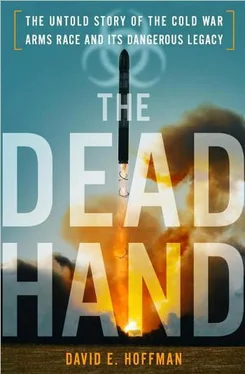The first part ended Biopreparat’s functioning as an offensive biological warfare organization, Alibek recalled in his memoir. The last part resurrected it.
Alibek protested, but Kalinin dismissed his worries with a flutter of his hand. “With this paper,” Kalinin said, “everyone gets to do what he wants to do.”
Using the Gorbachev order, Alibek said he sent a message to Stepnogorsk, the anthrax factory, and ordered the destruction of an explosive test chamber he had spent much time and effort to create. He also talked to Sandakhchiev at Vector about converting some facilities to civilian use. Alibek said he went to Siberia several times to oversee the conversion, which was completed by the end of 1990. But at the very same time, Sandakhchiev built a new facility for cultivating viruses for weapons, he said. “Similar double games were being played around The System,” he said. “While I closed production lines down,” Alibek said, another Biopreparat official “was authorizing new railcars for the mobile deployment of biological production plants.” 28
The United States and Great Britain, now in possession of Pasechnik’s detailed and frightening overview, quietly confronted the Soviets. On May 14, 1990, the British and American ambassadors in Moscow, Sir Rodric Braithwaite and Jack F. Matlock Jr., delivered a joint démarche, or formal protest. In separate meetings that afternoon, they took the protest to the heart of the leadership, meeting with Chernyaev, who was Gorbachev’s assistant, and Alexander Bessmertnykh, a deputy to Shevardnadze.
Matlock said Chernyaev “was not at all polemical” when the ambassadors delivered the protest. “He said immediately that there were three possibilities,” Matlock recalled. One was that the information was incorrect. “We of course interjected that we were certain it was correct,” Matlock said. Second, Chernyaev said, perhaps there was such a program and Gorbachev knew about it but had not told Chernyaev. Third, he said, it was possible such a program existed but neither he nor Gorbachev knew about it. “Chernyaev’s reply, allowing the possibility of a program with or without Gorbachev’s knowledge, was the first time I heard such a comment” from a Soviet official, Matlock recalled. 29
At the Foreign Ministry, Bessmertnykh took detailed notes. He recorded that Matlock and Braithwaite said the West had “new information” on specific Soviet biological weapons facilities, personnel and programs. They added, according to his notes, “We have a basis to suggest that in the USSR a large-scale secret program in the field of biological weapons is being carried out and there exists significant stockpiles of such weapons far in excess of the reasonable requirements for research purposes.”
The ambassadors insisted they did not want “public agitation” over the issue. Braithwaite appealed to Bessmertnykh to resolve it “without additional fuss.” Matlock said it was being handled only in top-secret channels, and the United States was “absolutely not interested in burdening our relations with a new problem on the eve of the most important negotiations at the highest levels.” The planned summit between Bush and Gorbachev in Washington was just weeks away. Bessmertnykh promised to inform Shevardnadze. 30
The démarche got the Kremlin’s attention. The next day, May 15, 1990, Zaikov sent a typewritten letter to Gorbachev. The letter, found in the Katayev archive, is a milestone in the story of the Biopreparat deception. It shows that Gorbachev personally instructed another Politburo member to report to him on biological weapons work.
Zaikov’s response was sent to Shevardnadze, too. “This is for your eyes only,” warned a small cover note to Shevardnadze, signed by Zaikov. 31
“In accordance with your instructions,” Zaikov wrote to Gorbachev, “I report to you on the subject of biological weapons.” The word biological was neatly handwritten in blank spaces throughout the letter, apparently because the issue was so ultrasensitive he did not want a typist to know.
Zaikov put a very selective spin on the past and present history of the biological warfare program. It is evident from the letter that Soviet officials lied not only to the world, but to each other, including to the president of the country. “In our country,” Zaikov told Gorbachev, “the development of biological weapons began in the 1950s at three USSR Ministry of Defense organizations, located in Kirov, Zagorsk, and Sverdlovsk.” In fact, the Soviet work on biological weapons dated back to the late 1920s. Zaikov had identified three of the military’s chief facilities in the postwar period, including Sverdlovsk.
“In 1971,” Zaikov continued, “they were joined in this work by another 12 organizations of the USSR Ministry of the Medical Industry and the former USSR State Agroindustrial Committee. By 1985, they had developed 12 recipes and means for using them. These were produced in suitable quantities, stored, and destroyed after the expiration of useful life (an average of 6 months.)” 32
Zaikov’s description hardly did justice to the ambitious quest for genetically engineered microbes, production and weaponization, and the string of laboratories and factories built by Biopreparat and the military. Zaikov then reviewed the history of the treaty, noting it “had no effective inspection mechanism for ensuring compliance, nor was there a precise definition of the difference between developing biological weapons and defensive means against them.”
Zaikov was correct that the boundary between offensive and defensive biological weapons work was sometimes unclear. But the Soviets had not just stepped over the line, they had taken giant and deliberate strides into activity clearly prohibited by international treaty. Zaikov did not inform Gorbachev of the Soviet violations. He instead claimed it was the West that may have violated the agreement.
Next, Zaikov described the high-level Soviet decision making on biological weapons in the last few years. He told Gorbachev that Soviet officials had concluded there was a possibility of inspections under a forthcoming global ban on chemical weapons, and even “possible” inspections to check on compliance with the 1972 biological weapons treaty. He reminded Gorbachev of the Central Committee decision of October 6, 1989, a few weeks before Pasechnik defected. That decision, Zaikov said, was that “all research capacity for biological weapons be redirected and used to develop defensive means against these weapons so as not to contradict our international obligations.” What Zaikov neglected to tell Gorbachev was that the October 6 decision also stated that the Soviet Union would try to “preserve” its “parity” in “military biology.”
Zaikov then told Gorbachev, “In 1988, the stocks of special recipes were destroyed, production of active materials at industrial facilities was halted, and special processing and munitions-assembly equipment was dismantled.” 33Zaikov went on to remind Gorbachev of the high-level decisions made earlier to accelerate the process of getting some facilities scrubbed for possible inspection. 34Three research laboratories “are currently being prepared for international inspection,” he said—Obolensk, where Popov and Domaradsky had worked on genetic engineering of bacteria and where Popov saw the guinea pigs die; Koltsovo, where Popov had first experimented with genetically modified viruses; and Pasechnik’s facility in Leningrad, where, among other things, he had explored how to produce agents more effectively and to make them even more potent. These three laboratories were at the heart of the Biopreparat program.
“It is possible that some Western circles have a heightened interest in our country’s compliance with the 1972 Convention after the defection of V. A. Pasechnik in France in October, 1989,” Zaikov wrote. Pasechnik, he added, “had knowledge of the content of special biological research work, as well as the locations of organizations involved in this work.”
Читать дальше












